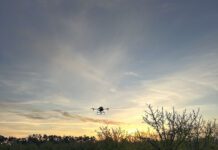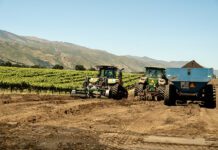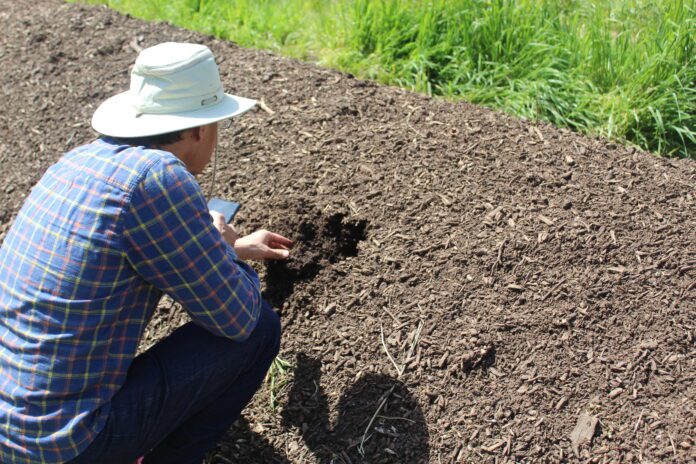
A field day held in a San Joaquin County walnut and cherry orchard highlighted the system-based approach Franz Eilers and Emma Wade have taken at Heartwood Farms in Linden, Calif., through biodiversity and whole-farm cycling of nutrients and carbon using orchard waste.
The Biologically Integrated Orchard Systems (BIOS) Whole Orchard Nutrient Cycling and On-Farm Composting event last spring was organized by Community Alliance with Family Farmers (CAFF), an organization that works on sustainable farming issues with farmers and ranchers through advocacy and on-the-ground education and cost-share programs.
A Home for Beneficial Pests
Heartwood Farms farm is a hub of biodiversity. A mix of cherries and nearly 50-year-old walnut trees, assorted cover crops welcome and support a variety of beneficial insects. Hanna Kahl, an ecological pest management specialist with CAFF, called Heartwood Farm highly biodiverse and and ideal environment for predators of pests like spider mite, which she said is becoming an increasingly bigger problem for walnut growers as the climate warms. She noted that CAFF’s ecological pest management program is conducting on-farm experiments with walnut growers, as well as wine grape growers, to learn how to control spider mites with funding from CDFA’s BIOS program.
“We do weekly sampling and monitoring to look at spider mite levels and predators of spider mites,” Kahl said, including predatory mites, six-spotted thrips, big eyed bugs, minute pirate bugs, and spider mite destroyers.
Heartwood Farms are in the process of transitioning their farm to fully organic, but Eilers said they have always relied on a minimalistic approach, continually aiming to time things just right without a lot of artificial pulling and pushing of the landscape.
“I think nature is a little freer to express herself here,” Eilers said.
Transforming Orchard Waste into Compost
The Heartwood Farms compost pile began almost a year prior to the March 2024 field day, following the pruning and mowing of cover crops in their walnut orchard. Converting a year’s worth of orchard waste into compost involves numerous considerations.
One of the first things they had to consider was figuring out how to turn wood prunings into a mountain of chips. Wade said that while there were many ways that could be done, they had to look at the most efficient method for their specific needs.
Ultimately, they chose to go with an 8-foot tub grinder, which produced a finer chipped wood than traditional orchard removal would have.
“The smaller the chip you have, the easier time you’re going to have to break it down,” Wade said.
The tub grinder, at an expense of about $3,500, was covered by the SARE grant. While pricier than burning, it’s an unavoidable cost to comply with strict burn restrictions.
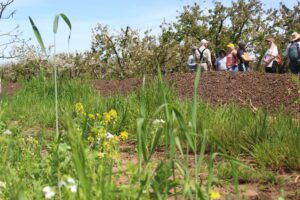
“Obviously $3,500 is more expensive than burning your wood, but we’re not allowed to do that anymore,” Wade said. “And what’s the cost of buying your compost? So, all of those things go into the picture.”
Once the wood debris were chipped, Eilers said he used a front-end loader to begin dumping piles where the 700-foot-long compost windrow would begin to take shape. The next component was to cut the cover crop, rake it up, and dump it on the top of the windrow at a ratio of about 1:1.
“We did that because the cover crop was a little bit mature, it was a little beyond its freshest point, otherwise we would have done a 2:1, 2 being wood chip, 1 being the nitrogen source of the cover crop,” Eilers said.
After that, they needed a tractor with a creeper gear, which allows it to operate slower than walking pace at a high RPM, a tractor they conveniently already possessed, which they mounted a compost turner on. Wade noted that the compost turner was not funded by the SARE grant, but a separate, healthy soils grant with a compost incentive did reimburse them for it.
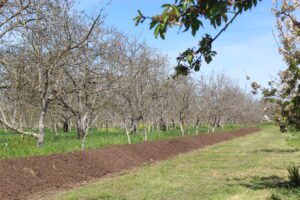
Once the orchard debris were mixed with the harvested cover crop, the compost required regular monitoring, watering, and turning as necessary. The pile was then turned weekly during the first month, biweekly the following month, and once more after that. They consistently monitored the temperature, which remained around an ideal temperature of 140 degrees F. Its location, offering a balanced mix of sunlight and shade, created an ideal environment for the composting process.
“Making compost is fun, it’s a lot of work, but if you can put the time it needs, particularly in that first couple of weeks, this thing is going to cook,” Wade said.
She added that results from a nutritional composition test showed their compost was garden grade and considered highly desirable.
That’s no small feat, according to Marney Blair, who served as a technical advisor to Wade and Eilers throughout the project.
“Their first time at it, that is highly commendable,” Blair said.
Blair noted that the advantages of on-farm compost hinge on three key factors: it acts as a biological infusion for the soil; it introduces essential micro-nutrients such as zinc, copper, and magnesium; and it enhances the soil’s physical structure by adding porosity and improving water retention.
Speaking to the economics of making compost, she said producers are starting to realize the more local they can be, the more economically sound they can be also.
“Composting can be extremely local,” she said. “Look what they’ve done, they’ve limbed their trees, they grew their over crop, and now they’ve created their own fertility. And it’s become this wonderful, circled system, that is a cost saving in itself.”
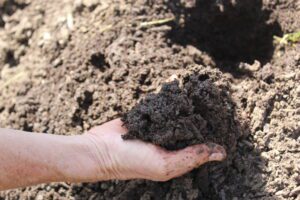
Farming as a System
Kahl says the point of the BIOS approach is to explore how the farm is managed as a system, with interlinking parts.
“You can’t really treat one part of the system in isolation, and so a lot of these practices weave together and complement each other,” she said. “Like irrigation might interact with pest management, which might interact with soil health, it’s a complex system.”
Funded by CDFA, the BIOS program aims to minimize chemical inputs like pesticides and fertilizers through the adoption of biological and cultural farming practices, thus lessening the environmental degradation associated with these substances.
“It’s just a really powerful, different approach in that, the way that we try to do things, is always to engage the grower first,” Kahl said.
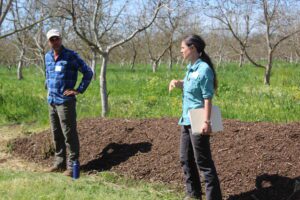
That engagement includes learning each growers’ story, figuring out what’s working well on their farm and what isn’t and bringing in the people and specialists that the grower wants to be included, not choosing for them, Kahl explained.
“Every event that we organize and everything we do, we talk to the farmer about highlighting them and showcasing their approaches, rather than bringing ourselves too much into it, really just trying to foster farmer-to-farmer co-learning,” she said.
More information about BIOS can be found at https://www.cdfa.ca.gov/oefi/opca/bifs.html
More information about CAFF and the incentive programs they offer can be found at https://caff.org

Kristin Platts | Digital Content Editor and Social Correspondence
Kristin Platts is a multimedia journalist and digital content writer with a B.A. in Creative Media from California State University, Stanislaus. She produces stories on California agriculture through video, podcasts, and digital articles, and provides in-depth reporting on tree nuts, pest management, and crop production for West Coast Nut magazine. Based in Modesto, California, Kristin is passionate about sharing field-driven insights and connecting growers with trusted information.








